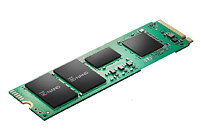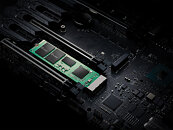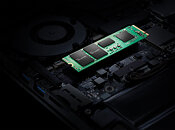Monday, March 1st 2021

Intel Rolls Out SSD 670p Mainstream NVMe SSD Series
Intel today rolled out the SSD 670p series, a new line of M.2 NVMe SSDs that are targeted at the mainstream segment. Built in the M.2-2280 form-factor with PCI-Express 3.0 x4 host-interface, the drive implements Intel's latest 144-layer 3D QLC NAND flash memory, mated with a re-badged Silicon Motion SM2265G 8-channel controller that uses a fixed 256 MB DDR3L DRAM cache across all capacity variants. It comes in capacities of 512 GB, 1 TB, and 2 TB.
The 1 TB and 2 TB variants offer sequential read speeds of up to 3500 MB/s, while the 512 GB variant reads at up to 3000 MB/s. Sequential write speeds vary, with the 512 GB variant writing at up to 1600 MB/s, the 1 TB variant at up to 2500 MB/s, and the 2 TB variant at up to 2700 MB/s. The drives offer significantly higher endurance than past generations of QLC-based drives, with the 512 GB variant capable of up to 185 TBW, the 1 TB variant up to 370 TBW, and the 2 TB variant up to 740 TBW. Intel is backing the drives with 5-year warranties. The 512 GB variant is priced at $89, the 1 TB variant at $154, and the 2 TB variant at $329.
The 1 TB and 2 TB variants offer sequential read speeds of up to 3500 MB/s, while the 512 GB variant reads at up to 3000 MB/s. Sequential write speeds vary, with the 512 GB variant writing at up to 1600 MB/s, the 1 TB variant at up to 2500 MB/s, and the 2 TB variant at up to 2700 MB/s. The drives offer significantly higher endurance than past generations of QLC-based drives, with the 512 GB variant capable of up to 185 TBW, the 1 TB variant up to 370 TBW, and the 2 TB variant up to 740 TBW. Intel is backing the drives with 5-year warranties. The 512 GB variant is priced at $89, the 1 TB variant at $154, and the 2 TB variant at $329.



92 Comments on Intel Rolls Out SSD 670p Mainstream NVMe SSD Series
budgetgarbage. :)EDIT: Wait, $154 for 1TB? Yeah, ignore the budget part then, this is more of a scamaz.
Seeing QLC at $150/TB is nonsensical. You can buy superior technology at lower prices. Intel is really damaging their name by offering a budget-tier QLC drive at prices this high IMO. TLC NVMe / PCIe 3.0 is selling at $120/TB or so, and would be a superior choice. Heck, given the slowdowns associated with QLC, you might even prefer SATA TLC at $80 to $100.
(Their Optanes are great and I have one, but they're priced in an entire different league.)
Intel's CPUs are underrated and I'm excited to see them enter the GPU market. But Intel's QLC storage has always been wtf to me. Intel does have a quality offering in the name of Optane (though very expensive).
The samsung 860 evo 1tb sata ssd with 560mb read is 130$ or above !
You can find a brand-name SATA TLC drive for $90 btw. Such as Crucial MX500 (www.newegg.com/crucial-bx500-1tb/p/N82E16820156231).
If you want cheap/capacity, SATA-TLC for the win. If you want performance, NVMe TLC for the win. Why buy the low-endurance low-performance QLC product in the middle? Once you account for QD1 performance, SATA-TLC starts to make more and more sense for cheap capacity.And the HP EX 920 has 3500 MBps read and 650TBW, because TLC beats QLC in both speed and endurance. Furthermore, actual practical tests (aka: QD1 IOPS speeds) strongly favor TLC drives. So the "hidden" advantage leans towards TLC drives like HP EX920 or even SATA-TLC drives in practice. Especially when the very slow continuous write speeds of QLC are taken into account ("continuous write" meaning after the SLC cache is exhausted).
www.techpowerup.com/273566/sk-hynix-to-acquire-intel-nand-flash-memory-business-for-usd-9-billionKeep in mind that prices of SSDs vary a lot depending on where people live.
In fact, the 665p isn't even available here and the older 660p costs $115 locally, at 1TB.
For slightly less I can get an XPG 8200 Pro, a WD Blue N550, a Sandisk Ultra 3D ($108) and a bunch of tier 2 and 3 drives from Apacer, Teamgroup, AGI, SEKC, TCell, Leven, Topmore, Klevv and so on. Most of these are using TLC rather than QLC.
Even in the US the SN550 can be had for around $100, which I'd rather get than a QLC drive from any brand.
The HP EX850 series was available for years, before being upgraded to the HP EX920 recently. HP's TLC drives have always been rated with high-reviews and "practical tests". Furthermore, Crucial's offerings (MX500) was following in a long line of TLC drives as well: MX100, BX100, etc. etc.
Samsung drives command a premium due to their popularity. But once you start looking at other top-tier brands (Crucial), or 2nd tier brands (ie: Mushkin, which is based off of Crucial NAND Flash), there were plenty of brands with superior quality over Intel's QLC drives, at much lower prices. HP, Crucial, Mushkin, ADATA, even WD drives I'd recommend over Intel for pretty much the entire existence of Intel's QLC line.
Intel commanded a premium years ago when they sold SLC drives before anyone else. Intel lost the crown around the MLC-drive (2-bits per cell) time period, and Samsung became king around that era. In the TLC-time period, Samsung had an early lead in price/performance/quality, but Crucial / Mushkin and HP really overtook Samsung years ago.
Really, the last time I'd say Intel was worth a recommendation was SLC-time frames or Optane. The SSD market has had a furious amount of competition over the years: its hard to keep up with who had the best brand (especially with Kingston's and ADATA's shenanigans). Still though, HP, Crucial, and Mushkin have reliably performed over the years, with Seagate and WD somehow managing to remain competitive as well (but never really "the best" IMO. Seagate purchase of Sandforce was clearly a good move... but Seagate ultimately relegated themselves to the enterprise market and seems to have left the consumer market).
-----
So once again:
* Intel won the SLC era for sure.
* Samsung won the early MLC era
* Crucial / Mushkin won the late MLC era
* Samsung won the early TLC era
* Crucial / Mushkin won the 2nd round of the TLC era
* HP suddenly comes out of no where and suddenly becomes a valid SSD manufacturer as the TLC / NVMe era begins
* Intel wishes to get a head start in the QLC era, but every time I look at their drives I'm WTFing because TLC drives are still better than Intel's offerings in basically every spec.
* NVMe / PCIe 4.0 begins with $200 / TB TLC drives from a variety of manufacturers, probably most useful for PS5 (because of the 5000+MBps requirements). We might be going faster rather than capacity: where TLC will have an advantage for some time over QLC. Hard to see the future from here.
* Intel Optane came around but was always too expensive for most people's purposes. Still, its very interesting, especially in the enterprise memory-only database market. (Slower than DDR4, but far faster than other SSDs in that application).
Crucial / Mushkin have very similar prices. Crucial makes its own SSDs, while Mushkin buys Crucial / Micron flash and assembles them into SSDs as well. I don't understand how that arrangement benefits them at all, but hey, they got some good prices and quality.
www.anandtech.com/show/16503/the-intel-ssd-670p-review
Second: IOPS at QD1 is a superior measurement of a typical PC's workload. QLC is well known to be bad at that benchmark compared to TLC (further processing is needed to get QLC to work).
------
Why spend an extra $30 on something worse than typical $120 PCIe 3.0 NVMe TLC SSDs? Crucial 1TB P5, HP EX950, WD Blue SN550, etc. etc. So many NVMe SSDs out there at way cheaper prices and similar (or even superior) performance.
Crap QLC drive - Let's sell them at TLC prices
Nope just Nope.
24h.pchome.com.tw/prod/DRAH7H-A9009ABWKAnd that's what Microsoft supposedly put in the Xbox series X and S...Anandtech went as far as saying harddrive speeds...